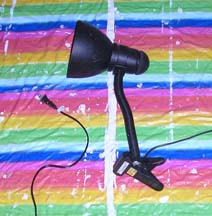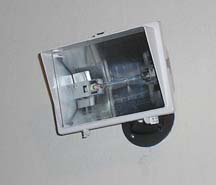
Don't rely on room lighting. Your head's shadow will cover everything you look at and your hand's shadow will cover everything you do. Light from above creates glare. Light should come in from both sides. You can't have too much light.
| Angela
Young Studios home page |
Contact Angela Young |
My husband Ken worked in Silicon Valley in the 1980s setting up labs for startups. Since then he transferred his experience to art studios. He wants to share his insights with you. Please use as many of these notes as you like.
 |
Don't rely on room lighting. Your head's shadow will cover everything you look at and your hand's shadow will cover everything you do. Light from above creates glare. Light should come in from both sides. You can't have too much light. |
 |
Track lighting is the best way to go. Use high wattage incandescent spotlights. Install one track per work area, each with it's own switch. It's worth the money. |
 |
Clamp lights work when installing a track is impractical. Clamp a light or two to something on either side, and you're ready to go. Use high wattage incandescent spotlights. If there is nothing to clamp onto, get something from the lumberyard and screw it to the wall to make an attractive clamping-point. |
 |
Unnecessary lighting is necessary. Use 500W halogens pointed at the ceiling for indirect lighting. The light bounces around and illuminates everything from all angles. They can be installed in wall sconces, they can be outdoor work lights, and they are even available as clamp lights. I recommend one from either side in a room, and twice the amount for a converted garage. Be able to turn on each light independently. |
Install lots of power outlets if you can. One every 3-5 feet or so along every wall is usually adequate. Have the electrician connect the new outlets to a different circuit breaker and color code the wall plates according to the breaker that supplies them. This lets you plug things in without fear of blowing breakers.
Put a portable power strip or two in every work area if installing more wall sockets is impractical. You need 3 times as many sockets as you think.
Put a sink in your studio if you can. Bigger is better.
Pick a room with north facing windows, or install them if possible. Natural light is best, but direct sunlight is bad. Two little windows are better than one big one.
Garage conversions should retain the big door if possible. It simplifies access for large items and makes it easier to get a permit.
Don't skimp on storage space, shelves, and cabinets. Cluttered floors and tabletops are bad for the morale and hard to work around.
Make a list of consumables that the studio is supposed to have and
"min/max" them. This way you will never run out of anything you need or
have too many sitting around taking up space or getting too old to use.
Consumables are things like paint and canvas.
Min/max means that if something runs low (falls below the minimum),
you put in an order so that everything is stocked up to the maximum.
Check your inventory if you use something up.
Example: You stock titanium white at 3/5 (min=3, max=5), cadmium red at 2/3, and yellow ochre at 2/3. You used up a titanium white today, so you quickly check your inventory. You have 2 whites, 2 reds, and 3 yellows. White is below the minimum so you put in an order. You order 3 whites and a red to take everything back up to the max.